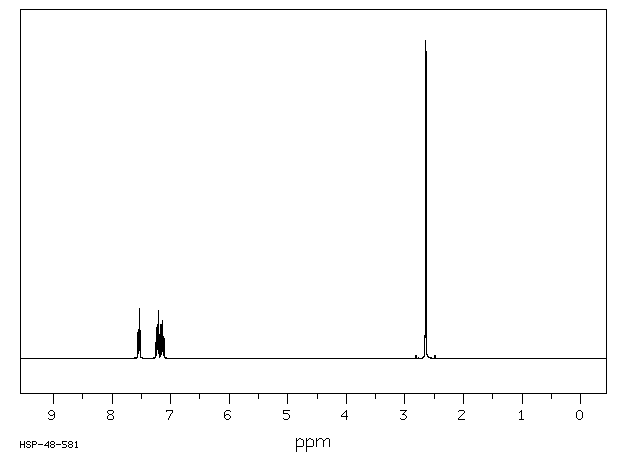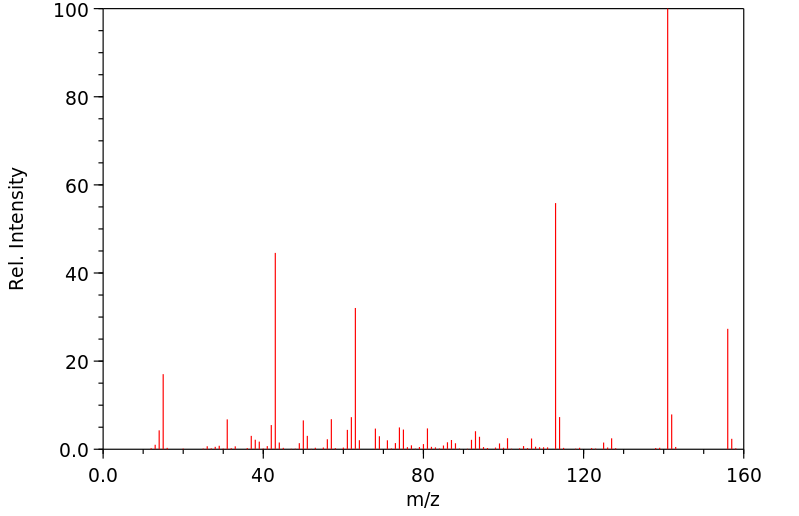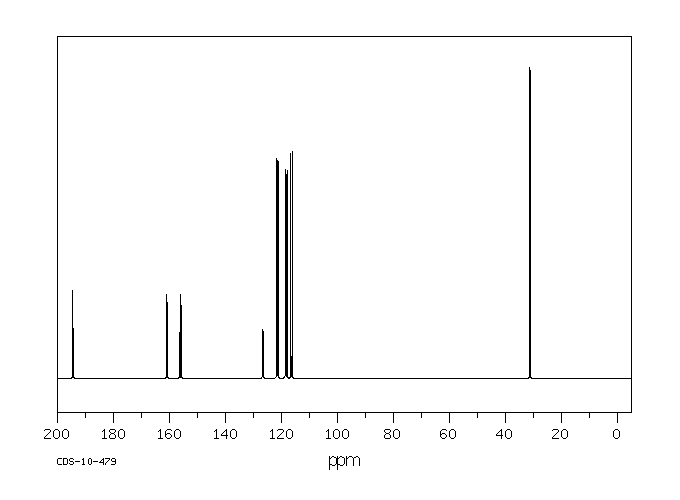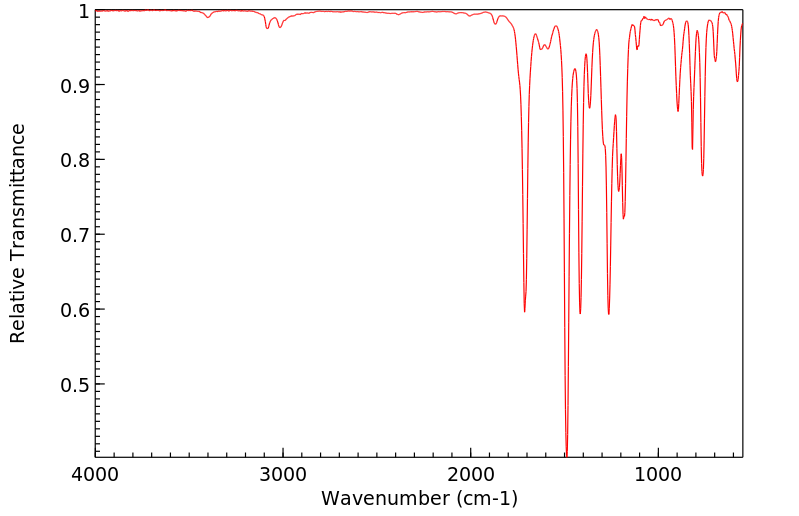2,5-二氟苯乙酮 | 1979-36-8
中文名称
2,5-二氟苯乙酮
中文别名
2',5'-二氟苯乙酮;2’,5’-二氟苯乙酮
英文名称
2',5'-difluoroacetophenone
英文别名
1-(2,5-difluorophenyl)ethanone;1-(2,5-difluorophenyl)ethan-1-one
CAS
1979-36-8
化学式
C8H6F2O
mdl
MFCD00009898
分子量
156.132
InChiKey
HLAFIZUVVWJAKL-UHFFFAOYSA-N
BEILSTEIN
——
EINECS
——
-
物化性质
-
计算性质
-
ADMET
-
安全信息
-
SDS
-
制备方法与用途
-
上下游信息
-
文献信息
-
表征谱图
-
同类化合物
-
相关功能分类
-
相关结构分类
物化性质
-
沸点:78-80°C 12mm
-
密度:1.233 g/mL at 25 °C(lit.)
-
闪点:>230 °F
-
溶解度:可溶于氯仿、乙酸乙酯
-
稳定性/保质期:
如果按照规格使用和储存,则不会分解,没有已知危险反应,应避免接触氧化物。
计算性质
-
辛醇/水分配系数(LogP):1.8
-
重原子数:11
-
可旋转键数:1
-
环数:1.0
-
sp3杂化的碳原子比例:0.125
-
拓扑面积:17.1
-
氢给体数:0
-
氢受体数:3
安全信息
-
危险等级:IRRITANT
-
危险品标志:Xi
-
安全说明:S26,S37/39
-
危险类别码:R36/37/38
-
WGK Germany:3
-
海关编码:2914700090
-
危险类别:IRRITANT
-
危险标志:GHS07
-
危险性描述:H315,H319,H335
-
危险性防范说明:P261,P305 + P351 + P338
SDS
| Name: | 2 5 -Difluoroacetophenone 98% Material Safety Data Sheet |
| Synonym: | None |
| CAS: | 1979-36-8 |
Synonym:None
Section 2 - COMPOSITION, INFORMATION ON INGREDIENTS
| CAS# | Chemical Name | content | EINECS# |
| 1979-36-8 | 2',5'-Difluoroacetophenone | 98% | 217-837-4 |
Risk Phrases: 36/37/38
Section 3 - HAZARDS IDENTIFICATION
EMERGENCY OVERVIEW
Irritating to eyes, respiratory system and skin.The toxicological properties of this material have not been fully investigated.
Potential Health Effects
Eye:
Causes eye irritation.
Skin:
Causes skin irritation.
Ingestion:
May cause gastrointestinal irritation with nausea, vomiting and diarrhea. The toxicological properties of this substance have not been fully investigated.
Inhalation:
Causes respiratory tract irritation. The toxicological properties of this substance have not been fully investigated.
Chronic:
No information found.
Section 4 - FIRST AID MEASURES
Eyes: Immediately flush eyes with plenty of water for at least 15 minutes, occasionally lifting the upper and lower eyelids. Get medical aid.
Skin:
Get medical aid. Flush skin with plenty of water for at least 15 minutes while removing contaminated clothing and shoes. Wash clothing before reuse.
Ingestion:
Never give anything by mouth to an unconscious person. Get medical aid. Do NOT induce vomiting. If conscious and alert, rinse mouth and drink 2-4 cupfuls of milk or water. Wash mouth out with water.
Inhalation:
Remove from exposure and move to fresh air immediately. If not breathing, give artificial respiration. If breathing is difficult, give oxygen. Get medical aid.
Notes to Physician:
Treat symptomatically and supportively.
Section 5 - FIRE FIGHTING MEASURES
General Information:
As in any fire, wear a self-contained breathing apparatus in pressure-demand, MSHA/NIOSH (approved or equivalent), and full protective gear. During a fire, irritating and highly toxic gases may be generated by thermal decomposition or combustion. Use water spray to keep fire-exposed containers cool. Vapors may be heavier than air. They can spread along the ground and collect in low or confined areas. Containers may explode when heated.
Extinguishing Media:
Use agent most appropriate to extinguish fire. Cool containers with flooding quantities of water until well after fire is out. Use water spray, dry chemical, carbon dioxide, or appropriate foam.
Section 6 - ACCIDENTAL RELEASE MEASURES
General Information: Use proper personal protective equipment as indicated in Section 8.
Spills/Leaks:
Absorb spill with inert material (e.g. vermiculite, sand or earth), then place in suitable container. Avoid generating dusty conditions.
Remove all sources of ignition. Provide ventilation. Clean up residual material by washing area with a 2-5% solution of soda ash.
Section 7 - HANDLING and STORAGE
Handling:
Wash thoroughly after handling. Use with adequate ventilation. Avoid contact with eyes, skin, and clothing. Keep container tightly closed.
Avoid ingestion and inhalation. Wash clothing before reuse.
Storage:
Store in a tightly closed container. Store in a cool, dry, well-ventilated area away from incompatible substances.
Section 8 - EXPOSURE CONTROLS, PERSONAL PROTECTION
Engineering Controls:
Facilities storing or utilizing this material should be equipped with an eyewash facility and a safety shower. Use adequate ventilation to keep airborne concentrations low.
Exposure Limits CAS# 1979-36-8: Personal Protective Equipment Eyes: Wear appropriate protective eyeglasses or chemical safety goggles as described by OSHA's eye and face protection regulations in 29 CFR 1910.133 or European Standard EN166.
Skin:
Wear appropriate protective gloves to prevent skin exposure.
Clothing:
Wear appropriate protective clothing to prevent skin exposure.
Respirators:
A respiratory protection program that meets OSHA's 29 CFR 1910.134 and ANSI Z88.2 requirements or European Standard EN 149 must be followed whenever workplace conditions warrant respirator use.
Section 9 - PHYSICAL AND CHEMICAL PROPERTIES
Physical State: Liquid
Color: light brown - colorless
Odor: Not available.
pH: Not available.
Vapor Pressure: Not available.
Viscosity: Not available.
Boiling Point: Not available.
Freezing/Melting Point: Not available.
Autoignition Temperature: Not available.
Flash Point: > 110 deg C (> 230.00 deg F)
Explosion Limits, lower: Not available.
Explosion Limits, upper: Not available.
Decomposition Temperature:
Solubility in water:
Specific Gravity/Density: 1.2330g/cm3
Molecular Formula: C8H6F2O
Molecular Weight: 156.13
Section 10 - STABILITY AND REACTIVITY
Chemical Stability:
Stable at room temperature in closed containers under normal storage and handling conditions.
Conditions to Avoid:
Incompatible materials, excess heat.
Incompatibilities with Other Materials:
Strong bases, strong oxidizing agents.
Hazardous Decomposition Products:
Carbon monoxide, irritating and toxic fumes and gases, carbon dioxide, hydrogen fluoride gas.
Hazardous Polymerization: Has not been reported
Section 11 - TOXICOLOGICAL INFORMATION
RTECS#:
CAS# 1979-36-8 unlisted.
LD50/LC50:
Not available.
Carcinogenicity:
2',5'-Difluoroacetophenone - Not listed by ACGIH, IARC, or NTP.
Section 12 - ECOLOGICAL INFORMATION
Section 13 - DISPOSAL CONSIDERATIONS
Dispose of in a manner consistent with federal, state, and local regulations.
Section 14 - TRANSPORT INFORMATION
IATA
Not regulated as a hazardous material.
IMO
Not regulated as a hazardous material.
RID/ADR
Not regulated as a hazardous material.
Section 15 - REGULATORY INFORMATION
European/International Regulations
European Labeling in Accordance with EC Directives
Hazard Symbols: XI
Risk Phrases:
R 36/37/38 Irritating to eyes, respiratory system
and skin.
Safety Phrases:
S 26 In case of contact with eyes, rinse immediately
with plenty of water and seek medical advice.
S 28A After contact with skin, wash immediately with
plenty of water.
S 37 Wear suitable gloves.
S 37/39 Wear suitable gloves and eye/face
protection.
S 45 In case of accident or if you feel unwell, seek
medical advice immediately (show the label where
possible).
WGK (Water Danger/Protection)
CAS# 1979-36-8: No information available.
Canada
None of the chemicals in this product are listed on the DSL/NDSL list.
CAS# 1979-36-8 is not listed on Canada's Ingredient Disclosure List.
US FEDERAL
TSCA
CAS# 1979-36-8 is not listed on the TSCA inventory.
It is for research and development use only.
SECTION 16 - ADDITIONAL INFORMATION
N/A
制备方法与用途
化学性质:无色透明的液态物质。
上下游信息
-
上游原料
中文名称 英文名称 CAS号 化学式 分子量 2,5-二氟苯甲醛 2,5-difluorobenzaldehyde 2646-90-4 C7H4F2O 142.105 -
下游产品
中文名称 英文名称 CAS号 化学式 分子量 2-溴-2’,5’-二氟苯乙酮 2-bromo-1-(2,5-difluorophenyl)ethanone 258513-41-6 C8H5BrF2O 235.028 —— (2,5-Difluoro-phenyl)-oxo-acetaldehyde 81593-28-4 C8H4F2O2 170.115 2-氯-2`,5`-二氟苯乙酮 2-chloro-1-(2,5-difluorophenyl)ethanone 60468-36-2 C8H5ClF2O 190.577 2,5-二氟苯甲酰基乙腈 3-(2,5-difluorophenyl)-3-oxopropanenitrile 71682-96-7 C9H5F2NO 181.142 —— 4-(2,5-difluorophenyl)-4-oxo-2E-butenoic acid 174415-29-3 C10H6F2O3 212.153 —— 1-(2,5-difluorophenyl)-3-phenylpropane-1,3-dione 1097121-93-1 C15H10F2O2 260.24 (2e)-1-(2,5-二氟苯基)-3-苯基-2-丙烯-1-酮 (E)-1-(2,5-difluorophenyl)-3-phenylprop-2-en-1-one 877862-83-4 C15H10F2O 244.241 2-溴-1-(2,6-二氟苯基)乙酮 2-bromo-1-(2,6-difluorophenyl)ethanone 56159-89-8 C8H5BrF2O 235.028 1-(2,5-二氟苯基)-4,4,4-三氟丁烷-1,3-二酮 2,5-difluorobenzoyltrifluoroacetone 35999-56-5 C10H5F5O2 252.141 —— (E)-4-(3-(2,5-difluorophenyl)-3-oxoprop-1-en-1-yl)benzoic acid —— C16H10F2O3 288.25 —— 1-(2,5-difluorophenyl)ethanol 126534-36-9 C8H8F2O 158.148 —— (R)-1-(2,5-difluorophenyl)ethanol 126534-37-0 C8H8F2O 158.148 —— 1-(2,5-difluorophenyl)ethanol 3874-31-5 C8H8F2O 158.148 —— (R)-1-(2,5-difluorophenyl)ethanamine —— C8H9F2N 157.163 2,5-二氟苯甲酸 2,5-difluorobenzoic acid 2991-28-8 C7H4F2O2 158.104 —— 4-(2,5-Difluoro-phenyl)-butyric acid 899350-25-5 C10H10F2O2 200.185 5,8-二氟-3,4-二氢-1(2H)-萘酮 5,8-difluoro-3,4-dihydronaphthalen-1(2H)-one 501373-03-1 C10H8F2O 182.17 - 1
- 2
反应信息
-
作为反应物:描述:2,5-二氟苯乙酮 在 hydrazine hydrate 作用下, 以 N,N-二甲基甲酰胺 为溶剂, 反应 18.0h, 以31%的产率得到6-氟-3-甲基-1H-吲唑参考文献:名称:EP3705478摘要:公开号:
-
作为产物:参考文献:名称:2,3-Difluorostyrene and 2-Chloro-5-fluorostyrene. The Preparation of Aromatic Fluorine Compounds摘要:DOI:10.1021/jo01062a067
文献信息
-
Highly Enantioselective Transfer Hydrogenation of Prochiral Ketones Using Ru(II)-Chitosan Catalyst in Aqueous Media作者:György Szőllősi、Vanessza Judit KolcsárDOI:10.1002/cctc.201801602日期:2019.1.23Unprecedentedly high enantioselectivities are obtained in the transfer hydrogenation of prochiral ketones catalyzed by a Ru complex formed in situ with chitosan chiral ligand. This biocompatible, biodegradable chiral polymer obtained from the natural chitin afforded good, up to 86 % enantioselectivities, in the aqueous‐phase transfer hydrogenation of acetophenone derivatives using HCOONa as hydrogen donor. Cyclic在与壳聚糖手性配体原位形成的Ru络合物催化的前手性酮的转移氢化中,获得了前所未有的高对映选择性。这种从天然几丁质中获得的生物相容性,可生物降解的手性聚合物,在使用HCOONa作为氢供体的苯乙酮衍生物的水相转移氢化中,提供了高达86%的良好对映选择性。环酮的对映选择性更高,超过90%,而在杂环酮的转移氢化中,进一步增加,最高可达97%。手性催化剂前体制备易地通过扫描电子显微镜,FT-中期和-far-IR光谱法检测。原位结构通过1 H NMR光谱和使用各种壳聚糖衍生物研究了形成的催化剂。结果表明,Ru预催化剂是通过氨基将生物聚合物与金属配位而形成的。加入氢供体后,该前体转化为水不溶性钌氢化物络合物。通过以高收率和光学纯度制备二十多种手性醇,验证了所开发方法的实用价值。在单次结晶后,将催化剂用于以克为单位获得光学纯的手性醇。
-
Mechanochemical, Water‐Assisted Asymmetric Transfer Hydrogenation of Ketones Using Ruthenium Catalyst作者:Vanessza Judit Kolcsár、György SzőllősiDOI:10.1002/cctc.202101501日期:2022.2.8The first highly efficient, aqueous phase mechanochemical asymmetric transfer hydrogenation of prochiral ketones is reported using in situ formed Noyori-Ikariya Ru-complex and sodium formate as hydrogen donor in ball mill.
-
N,O- vs N,C-Chelation in Half-Sandwich Iridium Complexes: A Dramatic Effect on Enantioselectivity in Asymmetric Transfer Hydrogenation of Ketones作者:Gang Zhou、Ahmed H. Aboo、Craig M. Robertson、Ruixia Liu、Zhenhua Li、Konstantin Luzyanin、Neil G. Berry、Weiping Chen、Jianliang XiaoDOI:10.1021/acscatal.8b02068日期:2018.9.7to a N,C- or N,O-chelated Cp*Ir(III) complex, depending on whether or not water was present in the reaction. While derived from the same precursor, these two complexes behaved in a dramatically different manner in asymmetric transfer hydrogenation (ATH) of ketones by formic acid, with the N,O-chelated complex being much more selective and active. The sense of asymmetric induction is also different, with
-
Cascade Trisulfur Radical Anion (S<sub>3</sub><sup>•–</sup>) Addition/Electron Detosylation Process for the Synthesis of 1,2,3-Thiadiazoles and Isothiazoles作者:Bei-Bei Liu、Hui-Wen Bai、Huan Liu、Shun-Yi Wang、Shun-Jun JiDOI:10.1021/acs.joc.8b01450日期:2018.9.7Trisulfur radical anion (S3•–) mediated reactions with in situ formed azoalkenes and α,β-usaturated N-sulfonylimines for the construction of 1,2,3-thiadiazoles and isothiazoles has been developed. S3•– is in situ generated from potassium sulfide in DMF. These two approaches provide a new, safe, and simple way to construct 4-subsituted 1,2,3-thiadiazoles, 5-subsituted 1,2,3-thiadiazoles, and isothiazole
-
Microwave‐assisted synthesis and luminescent activity of imidazo[1,2‐ <i>a</i> ]pyridine derivatives作者:Juan C. Rodríguez、Rony A. Maldonado、Gonzalo Ramírez‐García、Erik Díaz Cervantes、Fabiola N. CruzDOI:10.1002/jhet.3950日期:2020.5In this work, a series of phenacyl bromide derivatives was synthesized and employed as key intermediate for the synthesis of substituted imidazo[1,2‐a]pyridines. First, phenacyl bromide molecules were obtained from the bromination reaction of acetophenones assisted by microwave irradiation, obtaining the products 4a‐v in a 15 minutes reaction with yields in the range of 50% to 99%. Subsequently, the在这项工作中,合成了一系列苯甲酰溴衍生物,并用作合成取代的咪唑并[1,2- a ]吡啶的关键中间体。首先,在微波辐射的辅助下,通过苯乙酮的溴化反应获得苯甲酰溴分子,在15分钟的反应中获得产物4a-v,产率在50%至99%之间。随后,这些分子与2-氨基吡啶共轭,产生了咪唑并[1,2- a ]吡啶衍生物(7a-v)在60秒的反应中产率为24%至99%。相对于通过更繁琐的方法(如热辅助和机械辅助路线)获得的产量,确定了更高的产量。根据取代基的性质,在紫外线激发下观察到电磁光谱的紫色和蓝色区域中的强烈发光发射。这种对环境友好的方法有望构成一类重要的有机化合物,用于开发生物标志物,光化学传感器和医学应用。
表征谱图
-
氢谱1HNMR
-
质谱MS
-
碳谱13CNMR
-
红外IR
-
拉曼Raman
-
峰位数据
-
峰位匹配
-
表征信息
同类化合物
(反式)-4-壬烯醛
(s)-2,3-二羟基丙酸甲酯
([1-(甲氧基甲基)-1H-1,2,4-三唑-5-基](苯基)甲酮)
(Z)-4-辛烯醛
(S)-氨基甲酸酯β-D-O-葡糖醛酸
(S)-3-(((2,2-二氟-1-羟基-7-(甲基磺酰基)-2,3-二氢-1H-茚满-4-基)氧基)-5-氟苄腈
(R)-氨基甲酸酯β-D-O-葡糖醛酸
(5,5-二甲基-2-(哌啶-2-基)环己烷-1,3-二酮)
(2,5-二氟苯基)-4-哌啶基-甲酮
龙胆苦苷
龙胆二糖甲乙酮氰醇(P)
龙胆二糖丙酮氰醇(P)
龙胆三糖
龙涎酮
齐罗硅酮
齐留通beta-D-葡糖苷酸
鼠李糖
黑芥子苷单钾盐
黑海棉酸钠盐
黑木金合欢素
黑曲霉三糖
黑介子苷
黄尿酸8-O-葡糖苷
麻西那霉素II
麦迪霉素
麦芽糖脎
麦芽糖基海藻糖
麦芽糖1-磷酸酯
麦芽糖
麦芽四糖醇
麦芽四糖
麦芽十糖
麦芽六糖
麦芽五糖水合物
麦芽五糖
麦芽五糖
麦芽五糖
麦芽三糖醇
麦芽三糖
麦芽三糖
麦芽三塘水合
麦芽七糖水合物
麦芽七糖
麦法朵
麦可酚酸-酰基-Β-D-葡糖苷酸
麦利查咪
麝香酮
鹤草酚
鸢尾酚酮 3-C-beta-D-吡喃葡萄糖苷
鸡矢藤苷










